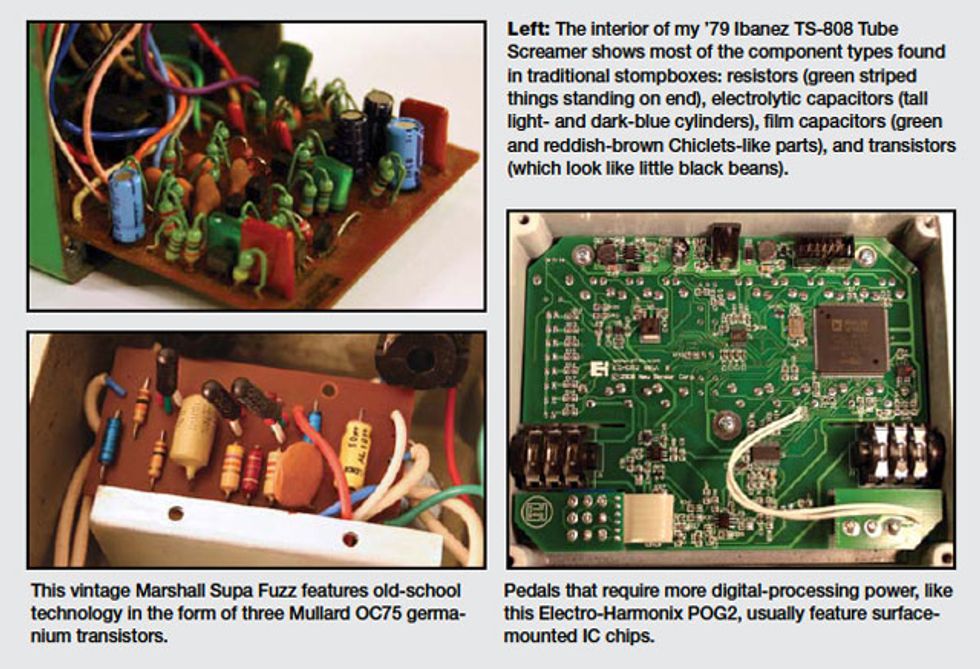Greetings, pedal stompers,
and welcome back to
Stomp School. It occurs to me
that I might have lost a few of
you in last month’s discussion
of technologies such as surface-mounted
devices (SMDs). I
initially considered addressing
this by following up with a
lengthy dissertation on the history
of surface-mount technology.
Then I thought, “Wait a
minute—I’m not an engineer,
I’m a guitar player!” My interest
in electronics and technology is
mainly focused on how it relates
to music gear, and I imagine the
same is true for most of you.
Obviously, there are a number
of bona fide engineers among
us, but most of us are not electronics
wizards—and some of
us are downright technophobic.
A subset of guitar-playing
gear enthusiasts have a heavy
interest in DIY stompboxes,
and there’s plenty of info on the
web that caters to them. But,
based on my experience, along
with feedback I’ve received on
the column, most players aren’t
inclined to pursue that degree
of dedication and expertise in
music electronics. Basically, we
want as much information as
will get us by. The question is,
“What will get us by—and how
and where do we find it?”
Fortunately, you don’t need an
engineering degree to get a better
understanding and appreciation
of what makes your pedals tick.
In fact, you can start right now
by doing this: Grab the pedal
closest to you, open it up, and
take a look inside (you’ll probably
have to get a Phillips-head
screwdriver first). Why would
you want to do this? Because it’s
one of the best ways to become
a more informed buyer. Even
if you know nothing about
electronics, it’s a habit that can
eventually become very instructive.
It can also help demystify a
lot of what would otherwise be a
bunch of marketing spiel. Think
of it as reading the ingredients
on a label in the grocery store
instead of relying on a TV commercial
for the product info.
The first thing I do when I get
a pedal is pop it open and look
inside. I think I’ve always done
it. Curiosity gets the better of me
and I can’t help it. It took a very
long time, however, before I had
the foggiest clue what I was looking
at. I was at least able to discern
such things as build quality
and the number of little doohickeys
on the circuit board, and that
was usually well worth the five
minutes it took to take a peek.
If you’ve never done it before
and the idea makes you a little
skittish, don’t worry. Unless
you’re unusually clumsy or careless,
you won’t hurt anything.
And if it’s a regular 9-volt-battery-
powered pedal, then there’s
nothing in there that will hurt
you. (Note: AC-powered gear is
another story, and guitar amps
often carry voltages that could
potentially be lethal. Let’s just
stick with pedals for now.)
The next best thing to looking
inside a stompbox is to
look at pictures of what we
lovingly refer to as “pedal guts.”
They say a picture is worth a
thousand words, so rather than
using a thousand words to
describe what I mean, let’s look
at the pictures below instead.
The first photo is of my
beloved circa-’79 Ibanez TS-808
Tube Screamer, and inside it
you can get a glimpse of traditional
“through-hole” electronics
on a single-sided printed
circuit board (PCB). Here you
can see most of the components
found in the majority of guitar
pedals. For the uninitiated,
resistors are the green things
with colored stripes that are
standing on end, electrolytic
capacitors are the tall lightand
dark-blue cylinders, film
capacitors are the big green and
reddish-brown things that look
like Chiclets gum, and transistors
look like little black beans.
If you look carefully, you can
also see ceramic capacitors, a
few diodes, and (hiding in the
electronic underbrush) a Texas
Instruments RC4558P IC chip.
The Electro-Harmonix
POG2, on the other hand, is
a cool pedal that incorporates
digital signal-processing circuitry.
It makes more sense to use
SMDs in effects like this.
On the other end of the
spectrum, you’ve got old-school
devices like the above gut shot
of a vintage Marshall Supa
Fuzz, which proudly sports
three Mullard OC75 germanium
transistors. That’s hot!
It’s good to know what goes
into making your tone. These
pictures (along with your own
research) should help provide a
visual reference for our future
discussions. With an open mind
and enough willingness, you
can easily learn enough to be
informed without giving up all
your valuable time to practice
and play music. We’ll get more
into various types of electronic
components next time. Until
then, keep on stompin’!
 Tom Hughes (aka
Analog Tom) is owner
and proprietor of
For Musicians Only
(formusiciansonly.com)
and author of Analog
Man’s Guide to Vintage
Effects. If you have questions or comments
for Tom, feel free to email him at
stompschool@formusiciansonly.com.
Tom Hughes (aka
Analog Tom) is owner
and proprietor of
For Musicians Only
(formusiciansonly.com)
and author of Analog
Man’s Guide to Vintage
Effects. If you have questions or comments
for Tom, feel free to email him at
stompschool@formusiciansonly.com.







![Rig Rundown: Russian Circles’ Mike Sullivan [2025]](https://www.premierguitar.com/media-library/youtube.jpg?id=62303631&width=1245&height=700&quality=70&coordinates=0%2C0%2C0%2C0)

















